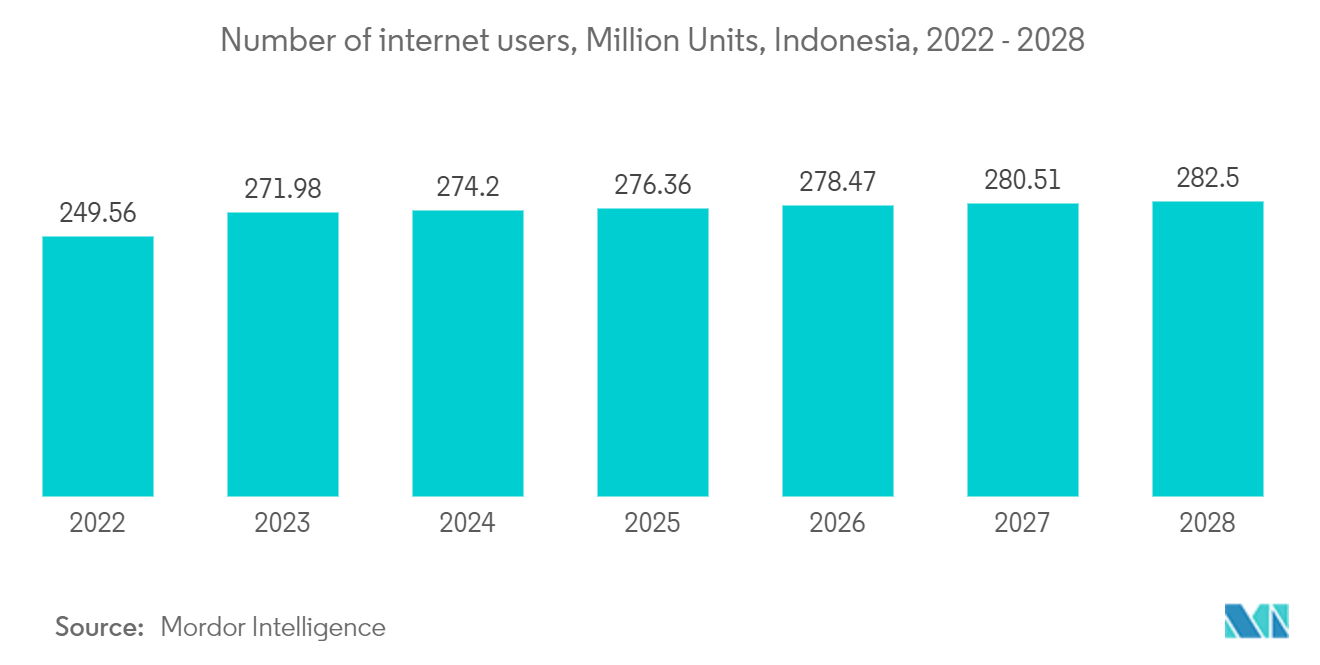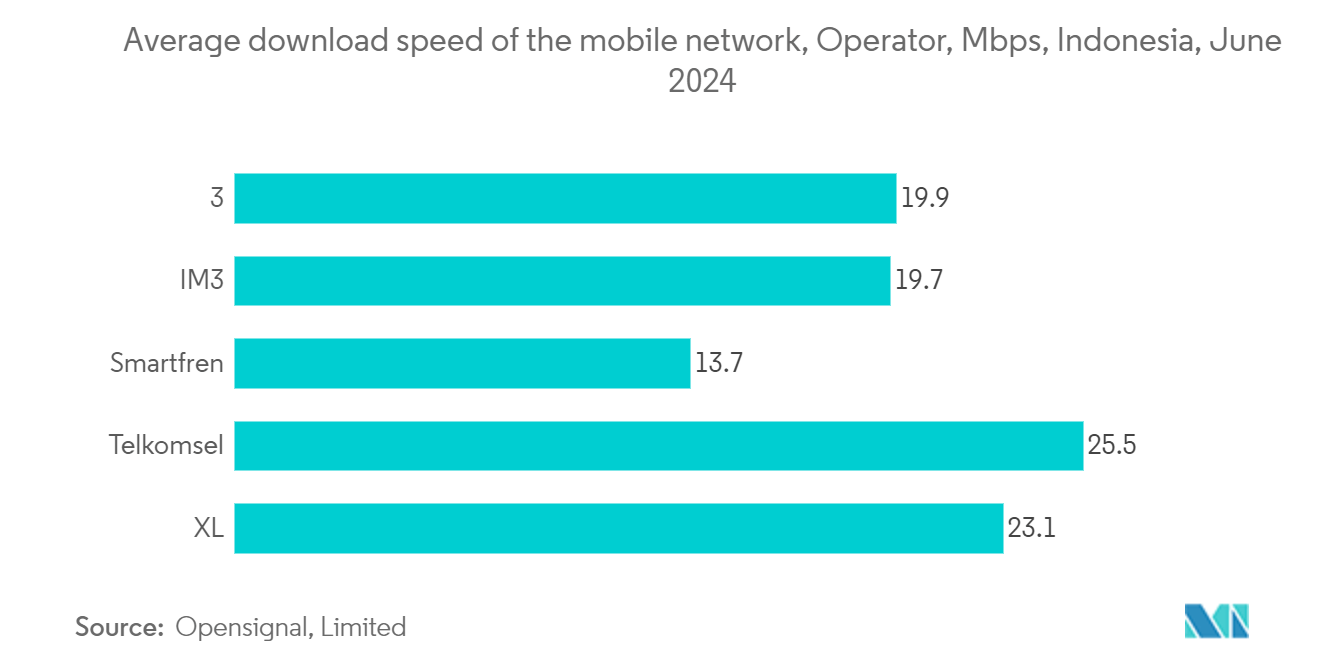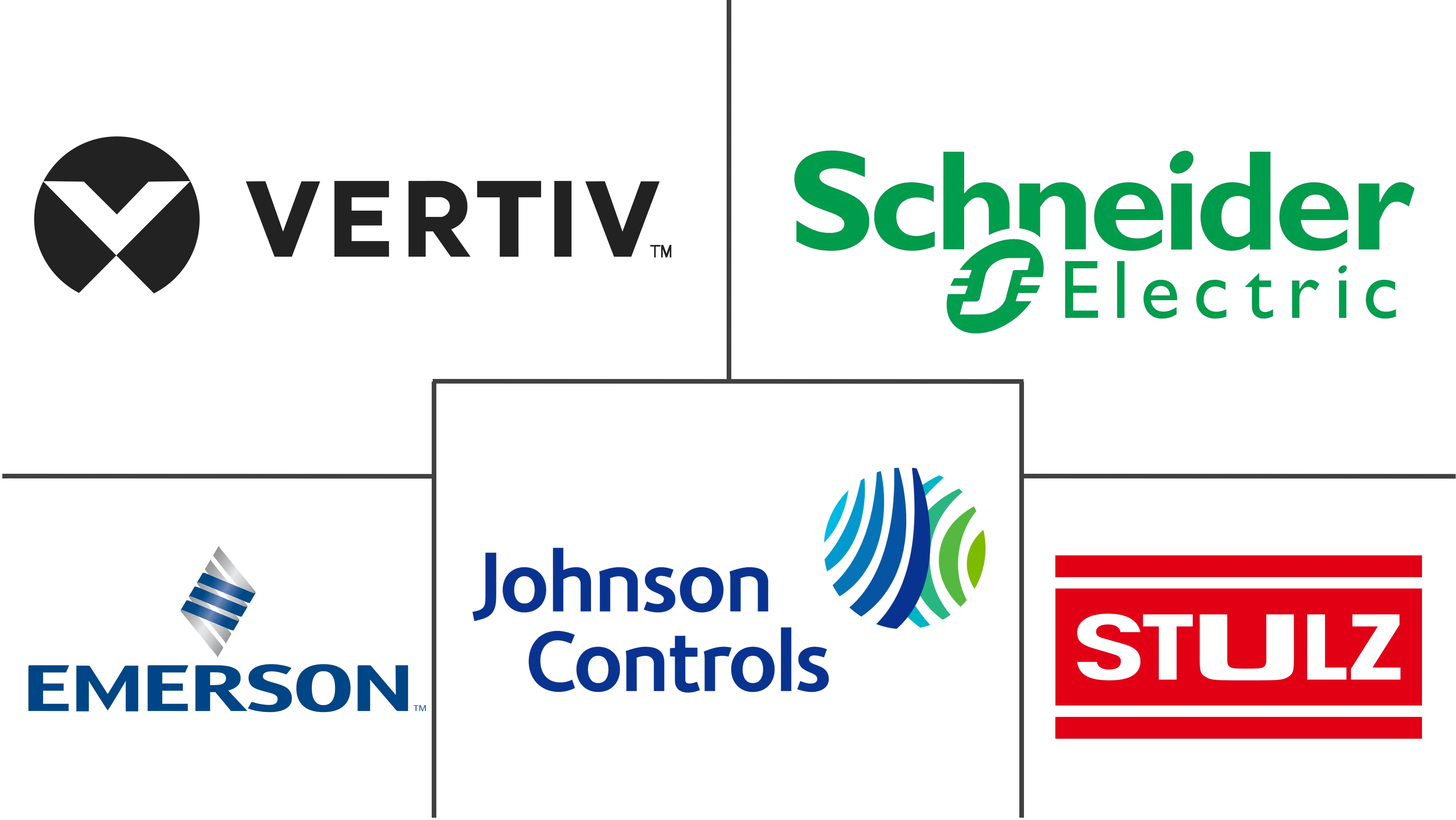Indonesia Data Center Cooling Market Size and Share

Indonesia Data Center Cooling Market Analysis by Mordor Intelligence
The Indonesia Data Center Cooling Market size is estimated at USD 106.00 million in 2025, and is expected to reach USD 327.75 million by 2031, at a CAGR of 20.7% during the forecast period (2025-2031).
- The increasing demand for cloud computing among SMEs, government regulations for local data security, and growing investment by domestic players are some of the major factors driving the demand for data centers in Indonesia.
- The upcoming IT load capacity of the Indonesian data center market is expected to reach more than 1400 MW by 2030. The country's construction of raised floor area is expected to increase above 4.3 million sq. ft by 2030.
- The country's total number of racks to be installed is expected to reach above 2,18,000 units by 2030. Greater Jakarta is expected to house the maximum number of racks by 2030. The average annual temperature in Indonesia ranges between 23 degrees Celsius and 28 degrees Celsius. Growing hyperscale demand is expected to increase the penetration of liquid cooling solutions in Indonesia in the coming years.
- There are close to 58 submarine cable systems connecting Indonesia, and many are under construction. Indonesia is the world's largest archipelago (group of islands), comprising over 17,000 islands, making it a challenging terrain for building even a telecommunication network. Central Indonesia, predominantly the Greater Jakarta hotspot region, is more developed in terms of economic, physical, and digital infrastructure, making it more suitable for constructing data centers. During 2017-2022, 15 data center facilities with a combined IT load capacity of ~100 MW were commissioned, which helped the Greater Jakarta region surpass the market share of 50% in the Indonesian market.
Indonesia Data Center Cooling Market Trends and Insights
Liquid-based Cooling Witnessing the Fastest Growth
- Technological advances have made liquid cooling easier to maintain, more scalable, and more affordable, reducing data center liquid consumption by more than 15% in tropical climates and by 80% in greener areas. The energy used for liquid cooling can be recycled to heat buildings and water, and advanced artificial refrigerants can effectively reduce the carbon footprint of air conditioners.
- Liquid cooling takes advantage of the superior heat transfer properties of water or other liquids to support efficient and cost-effective cooling of high-density racks, up to 3,000 times more effective than using air. Long proven in mainframe and gaming applications, liquid cooling is increasingly being used to protect rack servers in data centers across the region.
- Direct liquid cooling (DLC) solutions achieve partial power usage effectiveness (PUE) of 1.02 to 1.03, outperforming the most efficient air cooling systems by low single-digit percentages. However, PUE is not responsible for much of the DLC's energy gain. Traditional servers have fans that use power from the rack, so control is included in the IT power section of the PUE. These are considered part of the data center payload.
- Water cooling can be essential in minimizing emissions and reducing climate disturbance. Data centers using water as a cooling substance use about 10% less energy than most air-cooled data centers, emitting about 10% less CO2. Water cooling could reduce energy-related CO2 emissions in the data center portfolio by about 300,000 tonnes.

IT & Telecommunication is the Largest Segment
- Indonesia's digital economy is expected to add USD 150 billion to GDP by 2025. The Indonesian government is undertaking large-scale infrastructure development to achieve this goal. The government has launched several national initiatives such as the 100 Smart Cities Movement, e-Smart IKM, and Go Digital Vision 2020 as part of the digital transformation.
- According to the Chief Economist of the Economist Intelligence Unit, Indonesia is a good place to invest in digital technology because it is the largest market in Southeast Asia. Due to the potential of cloud business, many digital giants are building data centers in the country. As a result, cloud computing offers a range of benefits that match its operations and goals. The government has recognized the importance of cloud migration to the country's digital economy development and has announced plans to facilitate adoption through further regulatory development.
- The Ministry of Communications and Information has created the Digital Indonesia 2021-2024 Strategy. Digital infrastructure, digital governance, digital economy, and digital society are the four main focus areas of the draft. This roadmap outlines Indonesia's policy objectives, implementation plans, and timeline for digital transformation. Another goal is to distribute the digital economy more fairly across the region.
- The telecommunication sector is projected to maintain its dominance due to the growing adoption of 5G networks among users. The 5G mobile data speed is expected to increase significantly, reaching 259.3 Mbps by 2029. This suggests increasing data traffic and growing demand for data center servers in the market.
- Indonesia's digital economy is growing rapidly, owing to the increasing adoption of digitalization and well-known online marketplaces such as Tokopedia and GoJek. The goal is to enable three stages of future cities: smart cities (comfortable, livable, and safe), greener cities (climate change and disaster resistant), and competitive, technology-based smart cities. To do so, the Indonesian government has launched a smart city initiative, City Vision Indonesia 2015-2045. Thus, the demand for data center facilities is expected to increase the demand for better cooling equipment.

Competitive Landscape
The Indonesian data center cooling market has gained a competitive edge in recent years and is moderately competitive. Currently, a few major players, including Stulz GmbH, Schneider Electric SE, Vertiv Group Corp., Johnson Controls International PLC, and Emerson Electric Co., dominate the market.
In March 2023, STULZ, a Hamburg-based mission-critical air conditioning company, made a significant announcement regarding its industry-leading CyberAir 3PRO DX series. Some units within this series are now equipped to utilize the low global warming potential (GWP) refrigerant R513A. This breakthrough development underscores the company's unwavering commitment to providing sustainable air conditioning systems for data centers. STULZ has also initiated further product transitions across its portfolio to expand the use of the R513A refrigerant.
Indonesia Data Center Cooling Industry Leaders
-
Stulz GmbH
-
Schneider Electric SE
-
Vertiv Group Corp.
-
Johnson Controls International PLC
-
Emerson Electric Co.
- *Disclaimer: Major Players sorted in no particular order

Recent Industry Developments
- November 2023: GIGABYTE's subsidiary, Giga Computing, a renowned player in AI & HPC servers and a pioneer in direct liquid cooling (DLC) and Immersion cooling, unveiled a suite of cutting-edge cooling solutions. The latest offerings from GIGABYTE include the DLC-ready servers, H263-S63-LAN1 & H273-Z80-LAN1, which complement its existing high-density server lineup. These servers are designed to support the NVIDIA Grace CPU & Grace Hopper Superchip. GIGABYTE's 1U dual-socket servers, the R183-S90-LAD1 & R183-Z90-LAD1, are equipped with GIGABYTE cold plates, catering to a wide array of computing requirements.
- June 2023: Sanyo Denki unveiled the San Ace 160AD, a groundbreaking 160x160x51 mm ACDC fan and waterproof ACDC fan. This innovative product boasts the industry's highest airflow and static pressure, making it an ideal choice for applications such as cooling switchboards, industrial equipment, and air conditioners. It excels in delivering exceptional cooling performance while maintaining low power consumption.
Indonesia Data Center Cooling Market Report Scope
Data center cooling is a set of techniques and technologies to maintain optimal operating temperatures in data center environments. Data center cooling is critical as data center facilities house many computer servers and network equipment that generate heat during operation. Efficient cooling systems are used to dissipate this heat and prevent equipment from overheating, ensuring continued reliable operation of the data center. Various methods, such as air conditioning, liquid cooling, and hot/cold aisle containment, are commonly used to control temperature and humidity in data centers.
The Indonesian data center cooling market is segmented by technology (air-based cooling (chiller and economizer, CRAH, cooling towers, and other cooling technology), liquid-based cooling (immersion cooling, direct-to-chip cooling, and rear-door heat exchanger)), type of data center (hyperscaler, enterprise, and colocation), and end-user industry (IT & telecom, retail & consumer goods, healthcare, media & entertainment, federal & institutional agencies, and other end-users). The market sizes and forecasts are provided in USD values for all the above segments.
| Air-based Cooling | Chiller and Economizer |
| CRAH | |
| Cooling Tower (Covers Direct, Indirect, and Two-stage Cooling) | |
| Other Cooling Technology | |
| Liquid-based Cooling | Immersion Cooling |
| Direct-to-Chip Cooling | |
| Rear-Door Heat Exchanger |
| Hyperscaler (Owned & Leased) |
| Enterprise (On-premise) |
| Colocation |
| IT & Telecom |
| Retail & Consumer Goods |
| Healthcare |
| Media & Entertainment |
| Federal & Institutional agencies |
| Other End Users |
| By Cooling Technology | Air-based Cooling | Chiller and Economizer |
| CRAH | ||
| Cooling Tower (Covers Direct, Indirect, and Two-stage Cooling) | ||
| Other Cooling Technology | ||
| Liquid-based Cooling | Immersion Cooling | |
| Direct-to-Chip Cooling | ||
| Rear-Door Heat Exchanger | ||
| By Type | Hyperscaler (Owned & Leased) | |
| Enterprise (On-premise) | ||
| Colocation | ||
| By End-user Vertical | IT & Telecom | |
| Retail & Consumer Goods | ||
| Healthcare | ||
| Media & Entertainment | ||
| Federal & Institutional agencies | ||
| Other End Users | ||
Key Questions Answered in the Report
How big is the Indonesia Data Center Cooling Market?
The Indonesia Data Center Cooling Market size is expected to reach USD 106.00 million in 2025 and grow at a CAGR of 20.70% to reach USD 327.75 million by 2031.
What is the current Indonesia Data Center Cooling Market size?
In 2025, the Indonesia Data Center Cooling Market size is expected to reach USD 106.00 million.
Who are the key players in Indonesia Data Center Cooling Market?
Stulz GmbH, Schneider Electric SE, Vertiv Group Corp., Johnson Controls International PLC and Emerson Electric Co. are the major companies operating in the Indonesia Data Center Cooling Market.
What years does this Indonesia Data Center Cooling Market cover, and what was the market size in 2024?
In 2024, the Indonesia Data Center Cooling Market size was estimated at USD 84.06 million. The report covers the Indonesia Data Center Cooling Market historical market size for years: 2019, 2020, 2021, 2022, 2023 and 2024. The report also forecasts the Indonesia Data Center Cooling Market size for years: 2025, 2026, 2027, 2028, 2029, 2030 and 2031.
Page last updated on:
Indonesia Data Center Cooling Market Report
Statistics for the 2025 Indonesia Data Center Cooling market share, size and revenue growth rate, created by Mordor Intelligence™ Industry Reports. Indonesia Data Center Cooling analysis includes a market forecast outlook for 2025 to 2031 and historical overview. Get a sample of this industry analysis as a free report PDF download.



